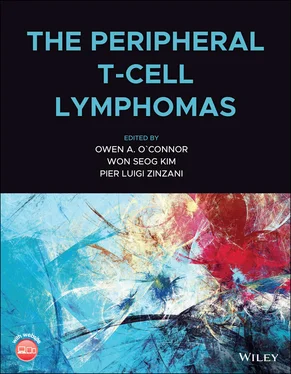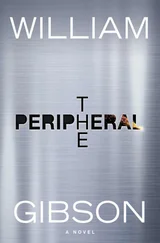9 9 Ji, M.M., Huang, Y.H., Huang, J.Y. et al. (2018). Histone modifier gene mutations in peripheral T‐cell lymphoma not otherwise specified. Haematologica 103 (4): 679–687.
10 10 Shah, U.A., Chung, E.Y., Giricz, O. et al. (2018). North American ATLL has a distinct mutational and transcriptional profile and responds to epigenetic therapies. Blood 132 (14): 1507–1518.
11 11 de Ruijter, A.J.M., van Gennip, A.H., and Caron, H.N. (2003). Histone deacetylases (HDACs): characterization of the classical HDAC family. Biochem J 370 (Pt 3): 737–749.
12 12 Bolden, J.E., Peart, M.J., and Johnstone, R.W. (2006). Anticancer activities of histone deacetylase inhibitors. Nat Rev Drug Discov 5 (9): 769–784.
13 13 Wang, Z., Zang, C., Cui, K. et al. (2009). Genome‐wide mapping of HATs and HDACs reveals distinct functions in active and inactive genes. Cell 138 (5): 1019–1031.
14 14 Dovey, O.M., Foster, C.T., and Cowley, S.M. (2010). Emphasizing the positive: a role for histone deacetylases in transcriptional activation. Cell Cycle 9 (14): 2700–2701.
15 15 Bertrand, P. (2010). Inside HDAC with HDAC inhibitors. Eur J Med Chem 45 (6): 2095–2116.
16 16 Hubbert, C., Guardiola, A., Shao, R. et al. (2002). HDAC6 is a microtubule‐associated deacetylase. Nature 417 (6887): 455–458.
17 17 Boyault, C., Sadoul, K., Pabion, M., and Khochbin, S. (2007). HDAC6, at the crossroads between cytoskeleton and cell signaling by acetylation and ubiquitination. Oncogene 26 (37): 5468–5476.
18 18 Vernin, C., Thenoz, M., Pinatel, C. et al. (2014). HTLV‐1 bZIP factor HBZ promotes cell proliferation and genetic instability by activating oncomiRs. Cancer Res 74 (21): 6082.
19 19 Mondello, P., Tadros, S., Teater, M. et al. (2020). Selective inhibition of HDAC3 targets synthetic vulnerabilities and activates immune surveillance in lymphoma. Cancer Discov 10 (3): 440–459.
20 20 Archer, S.Y., Meng, S., Shei, A., and Hodin, R.A. (1998). p21(WAF1) is required for butyrate‐mediated growth inhibition of human colon cancer cells. Proc Natl Acad Sci U S A 95 (12): 6791–6796.
21 21 Richon, V.M., Sandhoff, T.W., Rifkind, R.A., and Marks, P.A. (2000). Histone deacetylase inhibitor selectively induces p21WAF1 expression and gene‐associated histone acetylation. Proc Natl Acad Sci U S A 97 (18): 10014–10019.
22 22 Sasakawa, Y., Naoe, Y., Noto, T. et al. (2003). Antitumor efficacy of FK228, a novel histone deacetylase inhibitor, depends on the effect on expression of angiogenesis factors. Biochem Pharmacol 66 (6): 897–906.
23 23 Shao, Y., Gao, Z., Marks, P.A., and Jiang, X. (2004). Apoptotic and autophagic cell death induced by histone deacetylase inhibitors. Proc Natl Acad Sci U S A 101 (52): 18030–10835.
24 24 Carew, J.S., Nawrocki, S.T., Kahue, C.N. et al. (2007). Targeting autophagy augments the anticancer activity of the histone deacetylase inhibitor SAHA to overcome Bcr‐Abl‐mediated drug resistance. Blood 110 (1): 313–322.
25 25 Dunn, J., McCuaig, R., and Tu, W.J. (2015). Multi‐layered epigenetic mechanisms contribute to transcriptional memory in T lymphocytes. BMC Immunol 16: 27.
26 26 Antignano, F. and Zaph, C. (2015). Regulation of CD4 T‐cell differentiation and inflammation by repressive histone methylation. Immunol Cell Biol 93 (3): 245–252.
27 27 Toner, L.E., Vrhovac, R., Smith, E.A. et al. (2006). The schedule‐dependent effects of the novel antifolate pralatrexate and gemcitabine are superior to methotrexate and cytarabine in models of human non‐Hodgkin's lymphoma. Clin Cancer Res 12 (3): 924.
28 28 Paoluzzi, L., Scotto, L., Marchi, E. et al. (2010). Romidepsin and belinostat synergize the antineoplastic effect of bortezomib in mantle cell lymphoma. Clin Cancer Res 16 (2): 554.
29 29 Marchi, E., Paoluzzi, L., Scotto, L. et al. (2010). Pralatrexate is synergistic with the proteasome inhibitor Bortezomib in in vitro and in vivo models of T‐cell lymphoid malignancies. Clin Cancer Res 16 (14): 3648.
30 30 Kalac, M., Scotto, L., Marchi, E. et al. (2011). HDAC inhibitors and decitabine are highly synergistic and associated with unique gene‐expression and epigenetic profiles in models of DLBCL. Blood 118 (20): 5506–5516.
31 31 Jain, S., Jirau‐Serrano, X., Zullo, K.M. et al. (2015). Preclinical pharmacologic evaluation of pralatrexate and romidepsin confirms potent synergy of the combination in a murine model of human T‐cell lymphoma. Clin Cancer Res 21 (9): 2096.
32 32 Marchi, E., Zullo, K.M., Amengual, J.E. et al. (2015). The combination of hypomethylating agents and histone deacetylase inhibitors produce marked synergy in preclinical models of T‐cell lymphoma. Br J Haematol 171 (2): 215–226.
33 33 Zullo, K.M., Guo, Y., Cooke, L. et al. (2015). Aurora a kinase inhibition selectively synergizes with histone deacetylase inhibitor through cytokinesis failure in T‐cell lymphoma. Clin Cancer Res 21 (18): 4097–4109.
34 34 Odejide, O., Weigert, O., Lane, A.A. et al. (2014). A targeted mutational landscape of angioimmunoblastic T‐cell lymphoma. Blood 123 (9): 1293–1296.
35 35 Sakata‐Yanagimoto, M., Enami, T., Yoshida, K. et al. (2014). Somatic RHOA mutation in angioimmunoblastic T cell lymphoma. Nat Genet 46 (2): 171–175.
36 36 Couronné, L., Bastard, C., and Bernard, O.A. (2012). TET2 and DNMT3A mutations in human T‐cell lymphoma. N Engl J Med 366 (1): 95–96.
37 37 He, Y.F., Li, B.Z., Li, Z. et al. (2011). Tet‐mediated formation of 5‐carboxylcytosine and its excision by TDG in mammalian DNA. Science 333 (6047): 1303–1307.
38 38 Ito, S., Shen, L., Dai, Q. et al. (2011). Tet proteins can convert 5‐methylcytosine to 5‐formylcytosine and 5‐carboxylcytosine. Science 333 (6047): 1300–1303.
39 39 Tahiliani, M., Koh, K.P., Shen, Y. et al. (2009). Conversion of 5‐methylcytosine to 5‐hydroxymethylcytosine in mammalian DNA by MLL partner TET1. Science 324 (5929): 930.
40 40 Quivoron, C., Couronné, L., Della Valle, V. et al. (2011). TET2 inactivation results in pleiotropic hematopoietic abnormalities in mouse and is a recurrent event during human lymphomagenesis. Cancer Cell 20 (1): 25–38.
41 41 Muto, H., Sakata‐Yanagimoto, M., Nagae, G. et al. (2014). Reduced TET2 function leads to T‐cell lymphoma with follicular helper T‐cell‐like features in mice. Blood Cancer J 4 (12): e264‐e.
42 42 Lemonnier, F., Couronné, L., Parrens, M. et al. (2012). Recurrent TET2 mutations in peripheral T‐cell lymphomas correlate with TFH‐like features and adverse clinical parameters. Blood 120: 1466–1469.
43 43 Nagata, Y., Kontani, K., Enami, T. et al. (2016). Variegated RHOA mutations in adult T‐cell leukemia/lymphoma. Blood 127 (5): 596–604.
44 44 Gu, T., Lin, X., Cullen, S.M. et al. (2018). DNMT3A and TET1 cooperate to regulate promoter epigenetic landscapes in mouse embryonic stem cells. Genome Biol 19 (1): 88.
45 45 Cairns, R.A., Iqbal, J., Lemonnier, F. et al. (2012). IDH2 mutations are frequent in angioimmunoblastic T‐cell lymphoma. Blood 119 (8): 1901–1903.
46 46 Dawlaty, M.M., Breiling, A., Le, T. et al. (2014). Loss of Tet enzymes compromises proper differentiation of embryonic stem cells. Dev Cell 29 (1): 102–111.
47 47 Williams, K., Christensen, J., Pedersen, M.T. et al. (2011). TET1 and hydroxymethylcytosine in transcription and DNA methylation fidelity. Nature 473 (7347): 343–348.
48 48 Wu, H., D’Alessio, A.C., Ito, S. et al. (2011). Dual functions of Tet1 in transcriptional regulation in mouse embryonic stem cells. Nature 473 (7347): 389–393.
49 49 Lemonnier, F., Poullot, E., Dupuy, A. et al. (2018). Loss of 5‐hydroxymethylcytosine is a frequent event in peripheral T‐cell lymphomas. Haematologica 103 (3): e115.
50 50 Wang, C., McKeithan, T.W., Gong, Q. et al. (2015). IDH2R172 mutations define a unique subgroup of patients with angioimmunoblastic T‐cell lymphoma. Blood 126 (15): 1741–1752.
Читать дальше












